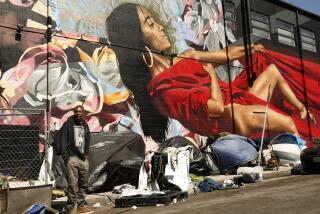L.A. voters just showed how frustrated they really are over traffic

A Times analysis of precinct data found a surge of voter support for transit spending across the county
Few people were more vocally opposed to a new transportation tax in Los Angeles County than Carson Mayor Albert Robles.
For months, Robles warned that Measure M gave the South Bay short shrift on transit and highway spending. He even backed a lawsuit over the ballot language.
For the record:
6:01 p.m. April 19, 2024An earlier version of this article described Glendora Mayor Gene Murabito as chairman of the Gold Line’s construction authority. He is vice-chairman of a board of elected officials that advises the agency building the light-rail line.
But his constituents weren’t convinced.
On election day, three out of four Carson voters supported the half-cent sales tax increase, despite the fact that the city will not receive any rail investment and will wait more than two decades for highway projects.
A Times analysis of precinct data found a surge of voter support for transit spending across the county, even in areas far from the urban core where transit service is less frequent and more residents drive, and in communities that are not slated to receive highway or rail projects.
The tax’s decisive victory of nearly 70% shows that voters are weary of Southern California’s traffic and are hungry for change, however imperfect or slow the solutions may be, experts say.
“It’s a statement of how frustrated and tired L.A. County voters are with the increasingly gridlocked lives they lead,” said Sherry Bebitch Jeffe, a professor of the practice of public policy communication at USC.
Measure M will raise the county’s base sales tax rate by a half-cent and is expected to generate $120 billion over the first four decades of assessment. The revenue will fund a range of transportation investments, including highway upgrades, local street repairs and a dramatic expansion of the region’s passenger rail network.
Four years ago, some of the county’s largest cities — Long Beach, Pasadena and Glendale — rejected Measure J, a proposed transit tax extension that would have raised $90 billion over three decades to accelerate construction on a half-dozen rail lines. The proposal fell about 16,000 votes shy of the two-thirds threshold.
This time around, voters in all three cities approved Metro’s ballot measure. Voter support jumped by 7 percentage points, to 72%, in Pasadena, where the decade-old Gold Line “has been a boon,” resident Cybele Garcia Kohel said.
Garcia Kohel, who has lived in Pasadena since 2003, voted for Measure M because she’s observed an influx of jobs and housing near Metro stations. The Gold Line there has helped commuters to get to work without driving, she said, helping the city’s culture shift “toward sustainable methods of commuting.”
Support wavered farther east, along a planned extension of the Gold Line to Claremont. That project is slated to open between 2025 and 2028, with three other routes scheduled to open in the five years after that.
Of the five cities set to receive stations on the planned extension, Claremont and Pomona hit the two-thirds threshold. But voters in the bedroom communities of Glendora, San Dimas and La Verne rejected the measure by more than 10 percentage points.
“A lot of people in San Dimas think the train is, at best, a mixed bag,” Mayor Curt Morris said. “Frankly, I have doubts in my own mind whether it’s even worthwhile to have a station here, for all the expense and disruption we’ll see.”
He worries that the rail line will cause traffic backups in downtown, and that a proposed overpass west of the city center will be ugly — although the City Council probably won’t spend extra to beautify it because, he said, “when you put lipstick on a pig, you’ve wasted the lipstick.”
But Glendora Mayor Gene Murabito, vice-chairman of a board of elected officials that advises the agency building the Gold Line, said even receiving a majority vote in the more conservative bedroom communities “is a very good sign that our residents are excited.”
A handful of cities whose elected officials vocally opposed the measure also saw two-thirds voter support. Representatives from Carson, Signal Hill, Norwalk, Pico Rivera and Beverly Hills warned voters that a tax with no end date would be a “blank check” for an agency that has struggled with cost overruns.
Robles, the Carson mayor, did not respond to requests for comment.
Cities in the southeast county, including Huntington Park and Commerce, also saw margins higher than 80%, despite protests from their elected leaders. That region is scheduled to receive one of the biggest projects on the expenditure list: a 20-mile light-rail line between Union Station and Artesia.
“If these guys were visible and loud in their opposition, and they were perceived as part of the establishment, that could have worked against them,” Bebitch Jeffe said. Distrust of legacy government figures can filter into local elections, she said, even when the alternative to the establishment is also a government agency.
Some conservative enclaves in the South Bay saw modest increases in voter support compared with the 2012 measure, though still well below the two-thirds threshold.
The coastal communities have a higher percentage of registered Republicans than the rest of the county and tend to be more fiscally conservative, said Heidi Ashcraft, a councilwoman in Torrance, where 55% of voters supported the tax increase.
“Voters in Torrance are well-informed and they pay attention,” Ashcraft said. “We as a city know it’s not going to be distributed fairly.”
A southern extension of the Green Line from the current terminus in Redondo Beach is slated to open in Torrance between 2030 and 2033. But, Ashcraft said, she’s skeptical that she’ll see the project “in my lifetime.”
More than three dozen neighborhoods in Los Angeles saw voter approval rates over 80%. Upticks in voter support in many areas mirrored Sherman Oaks, where the share of yes votes increased 3 percentage points to 74%.
Many commuters there will live less than a mile from a station along the rail tunnel through the Sepulveda Pass to connect the San Fernando Valley to the Westside, scheduled to open in 2033 to 2035.
Interested in the stories shaping California? Sign up for the free Essential California newsletter »
The largest percentile swings in voter support came from South Los Angeles, where voters will see investments in a new rapid bus line, but not rail.
Nearly a dozen areas, including Manchester Square and West Adams, saw double-digit swings in voter support. And nearly 83% of Inglewood voters supported the measure, a nine-point jump from 2012.
“Poor communities rely more on public transit,” Bebitch Jeffe said. “It doesn’t surprise me at all that they would vote for something that would improve the system they use.”
Follow @laura_nelson and @bposton on Twitter.
MORE LOCAL NEWS
‘Here I am above average’: Chinese ‘parachute kids’ are coming to the U.S. at younger ages
Could Donald Trump’s education policy change schools in California and nationwide?
California’s bullet train authority decides to buy American after all
More to Read
Start your day right
Sign up for Essential California for news, features and recommendations from the L.A. Times and beyond in your inbox six days a week.
You may occasionally receive promotional content from the Los Angeles Times.








